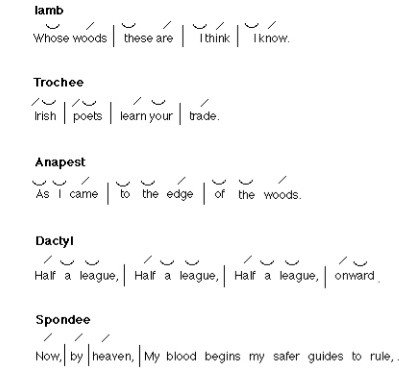Meter – Types Of Metrical Feet
METER: Meter is the pattern of stressed and unstressed syllables established in a line of poetry. The stressed ( ´ ) syllable is also called the accented syllable. The unstressed ( ˇ ) syllable is also called the unaccented syllable. In determining the meter, the importance of the word, the position in the metrical pattern, and other linguistic factors should be considered. In identifying the meter of a line or verse, the type and the number of feet are considered.
FOOT: A foot is a unit of meter. A metrical foot can have two or three syllables. A foot consists generally of one stressed and one or more unstressed syllables. A line may have one foot, two feet, etc. Poetic lines are classified according to the number of feet in a line.
TYPES OF METRICAL FEET:
A. IAMB: The iambic foot is a two-syllable foot with the stress on the second syllable. The iambic foot is the most common foot in English.
A book | of ver | ses un | der neath | the bough.
A jug | of wine, | a loaf | of bread | —and thou.
B. TROCHEE: The trochaic foot consists of a stressed syllable followed by an unstressed syllable.
Dou ble, | dou ble, | toil and | trou ble,
Fi re | burn and | caul dron | bu bble
Love again, | song again | nest again, | young again.
E. SPONDEE: The spondaic foot consists of two stressed syllables. Compound words are examples of spondees. They are used for variation.
Heartbreak, childhood, football

KINDS OF METRICAL LINES
A. MONOMETER: Following is an example of iambic monometer from “Upon His Departure” by Robert Herrick.
Thus I
Pass by
And die,
As one,
Unknown
And gone.
B. DIMETER: Below is an example of a poem called “Money” in trochaic dimeter by Richard Armour.
Workers earn it;
Spendthrifts burn it; Bankers lend it; Forgers fake it.
C. TRIMETER: Following is an example of iambic trimeter from a poem by Robert Bridges.
The idle life I lead
Is like a pleasant sleep,
Wherein I rest and heed The dreams that by me sweep.
D. TETRAMETER: Below is an example of iambic tetrameter from “Not Quite Fair” by Henry Leigh.
The hills, the meadows, and the lakes Enchant not for their own sweet sakes.
E. PENTAMETER: Some quotations from Alexander Pope illustrate iambic pentameter.
What oft was thought, but ne’er so well express’d. The bookful blockhead, ignorantly read,
With loads of learned lumber in his head.
F. HEXAMETER: (sometimes called an ALEXANDRINE)—note how the lines tend to fall into halves, with a CAESURA, or pause, in between.
If hunger, proverbs say, allures the wolf from wood, Much more the bird must dare a dash at something good.
G. HEPTAMETER: The iambic heptameter example is from “Casey at the Bat” by Ernest Thayer.
It looked extremely rocky for the Mudville nine that day, The score stood four to six with but an inning left to play:
H. OCTOMETER: Below is an example from “The Raven” by Edgar Allan Poe to illustrate trochaic octometer.
Once upon a midnight dreary, while I pondered, weak and weary,


